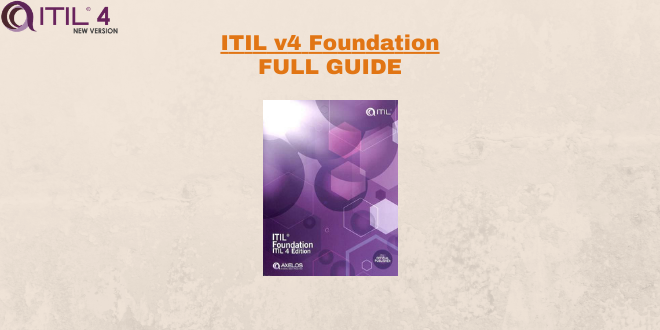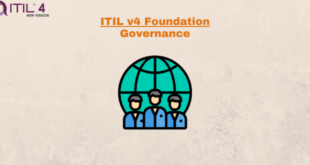Contents
- 1 Understanding of ITIL approach
- 2 Real world example [real estate company]
- 3 ITIL v4 – Foundation full guide
- 3.1 2.0 – Key concepts of service management
- 3.2 3.0 The four dimensions of service management
- 3.3 4.0 The ITIL Service Value System (SVS)
- 3.4 5.0 ITIL management practices
- 3.5 5.1 – ITIL General management practices
- 3.6 5.2 – ITIL Service management practices
- 3.7 5.3 – ITIL Technical management practices
Introducing the ITIL v4 Foundation framework, there are some parts that make perfect sense, others that might be a little bit ambiguous if it’s the first time you’re seeing some of these concepts. If this is your first time learning ITIL v4, it is recommended that you remove your ego from the equation when reading and absorbing the material. Ego and assumed knowledge can get in the way of understand how and why certain concepts are being used and will ultimately help you expand your own thinking.
ITIL v4 is comprised of non prescriptive methods to help any organization approach their own products, services & service offerings to produce co-created value for its service consumers (think customers) through Service Management (organizational capabilities for enabling value for customers in the form of services).
NOTE: I would strongly suggest that you purchase the official ITIL4 – Foundations guide and read through it while using this free guide as a follow along if you are self studying.
Understanding of ITIL approach
- Creation of value – Focus is around ‘co-created value’ between service providers/consumers
- Shared understanding (vision) – As many people within an organization should be keeping ITIL framework in their minds.
- Think holistically Remove ‘siloed’ thinking – Breaking down barriers between departments to enable better and more transparent communications.
- Service relationship – A cooperation between provider and consumer to ensure value is created and maintained.
- Practices – Using the right practices to enable business agility and building a solid ecosystem
- Continuous improvement – Always be thinking of how to optimize and improve
While this is a super simple overview, it is the thinking you will quickly realize once you start diving deeper into the ITIL framework.
Real world example [real estate company]
Throughout this guide we will be using a real world example of a real estate company. This was a company I personally worked for and where ITIL best practices were implement throughout all areas of the business. Real estate (being a very old industry) rarely leveraged technology and was stuck in very archaic ways of doing business. Across a 5 year period, the landscape of this organization will been changed to using new web technologies for curate new business, increased agility through highly automated processes and bring better service offerings to our customers through the co-creation of long term value.
ITIL v4 – Foundation full guide
2.0 – Key concepts of service management
- 2.1 – Value & value co-creation
- 2.2 – Organizations, service providers, service consumers, & other stakeholders
- 2.3 – Resources, products, services & service offerings
- 2.4 – Service relationships
- 2.5 – Value, outcomes, costs, risks, utility & warranty
3.0 The four dimensions of service management
- 3.1 – Organizations and people
- 3.2 – Information and technology
- 3.3 – Partners and suppliers
- 3.4 – Value streams and processes
- 3.5 – External factors (PESTLE)
4.0 The ITIL Service Value System (SVS)
- 4.1 – Service Value System overview
- 4.2 – Opportunity, demand & value
- 4.3 – 7 Guiding principles
- 4.4 – Governance
- 4.5 – Service Value Chain (SVC) & value streams
- 4.6 – Continual improvement
5.0 ITIL management practices
5.1 – ITIL General management practices
- 5.1.1 – Architecture management
- 5.1.2 – Continual improvement
- 5.1.3 – Information security management
- 5.1.4 – Knowledge management
- 5.1.5 – Measurement and reporting
- 5.1.6 – Organizational change management
- 5.1.7 – Portfolio management
- 5.1.8 – Project management
- 5.1.9 – Relationship management
- 5.1.10 – Risk management
- 5.1.11 – Service financial management
- 5.1.12 – Strategy management
- 5.1.13 – Supplier management
- 5.1.14 – Workforce and talent management
(Cheatsheet : General management practices)
5.2 – ITIL Service management practices
- 5.2.1 – Availability management
- 5.2.2 – Business analysis
- 5.2.3 – Capacity and performance management
- 5.2.4 – Change enablement
- 5.2.5 – Incident management
- 5.2.6 – IT asset management
- 5.2.7 – Monitoring and event management
- 5.2.8 – Problem management
- 5.2.9 – Release management
- 5.2.10 – Service catalogue management
- 5.2.11 – Service configuration management
- 5.2.12 – Service continuity management
- 5.2.13 – Service design
- 5.2.14 – Service desk
- 5.2.15 – Service level management
- 5.2.16 – Service request management
- 5.2.17 – Service validation and testing
(Cheatsheet : Service management practices)
5.3 – ITIL Technical management practices
- 5.3.1 – Deployment management
- 5.3.2 – Infrastructure and platform management
- 5.3.3 – Software development and management
 MooMetric.com Integrating marketing and business metrics using code and non code solutions.
MooMetric.com Integrating marketing and business metrics using code and non code solutions.

